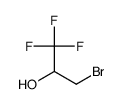3-bromo-1,1,1-trifluoro-2-propanol
Modify Date: 2024-01-19 18:56:55

3-bromo-1,1,1-trifluoro-2-propanol structure
|
Common Name | 3-bromo-1,1,1-trifluoro-2-propanol | ||
|---|---|---|---|---|
| CAS Number | 88378-50-1 | Molecular Weight | 192.96200 | |
| Density | 1.861 g/mL at 25ºC(lit.) | Boiling Point | 124.5ºC743 mm Hg(lit.) | |
| Molecular Formula | C3H4BrF3O | Melting Point | N/A | |
| MSDS | N/A | Flash Point | 110 °F | |
| Name | 3-bromo-1,1,1-trifluoro-2-propanol |
|---|---|
| Synonym | More Synonyms |
| Density | 1.861 g/mL at 25ºC(lit.) |
|---|---|
| Boiling Point | 124.5ºC743 mm Hg(lit.) |
| Molecular Formula | C3H4BrF3O |
| Molecular Weight | 192.96200 |
| Flash Point | 110 °F |
| Exact Mass | 191.94000 |
| PSA | 20.23000 |
| LogP | 1.30450 |
| Index of Refraction | n20/D 1.4(lit.) |
Synonym:3-Bromo-1,1,1-trifluoroisopropano Section 2 - COMPOSITION, INFORMATION ON INGREDIENTS
Risk Phrases: 36/37/38 Section 3 - HAZARDS IDENTIFICATION EMERGENCY OVERVIEW
Irritating to eyes, respiratory system and skin.The toxicological properties of this material have not been fully investigated. Potential Health Effects Eye: Causes eye irritation. Skin: Causes skin irritation. Ingestion: The toxicological properties of this substance have not been fully investigated. Inhalation: Causes respiratory tract irritation. The toxicological properties of this substance have not been fully investigated. Chronic: Not available. Section 4 - FIRST AID MEASURES Eyes: Flush eyes with plenty of water for at least 15 minutes, occasionally lifting the upper and lower eyelids. Get medical aid. Skin: Get medical aid. Flush skin with plenty of water for at least 15 minutes while removing contaminated clothing and shoes. Ingestion: Get medical aid. Wash mouth out with water. Inhalation: Remove from exposure and move to fresh air immediately. If not breathing, give artificial respiration. If breathing is difficult, give oxygen. Get medical aid. Notes to Physician: Section 5 - FIRE FIGHTING MEASURES General Information: As in any fire, wear a self-contained breathing apparatus in pressure-demand, MSHA/NIOSH (approved or equivalent), and full protective gear. Extinguishing Media: Use water spray, dry chemical, carbon dioxide, or chemical foam. Section 6 - ACCIDENTAL RELEASE MEASURES General Information: Use proper personal protective equipment as indicated in Section 8. Spills/Leaks: Absorb spill with inert material (e.g. vermiculite, sand or earth), then place in suitable container. Section 7 - HANDLING and STORAGE Handling: Avoid breathing dust, vapor, mist, or gas. Avoid contact with skin and eyes. Storage: Store in a cool, dry place. Store in a tightly closed container. Section 8 - EXPOSURE CONTROLS, PERSONAL PROTECTION Engineering Controls: Use adequate ventilation to keep airborne concentrations low. Exposure Limits CAS# 88378-50-1: Personal Protective Equipment Eyes: Wear appropriate protective eyeglasses or chemical safety goggles as described by OSHA's eye and face protection regulations in 29 CFR 1910.133 or European Standard EN166. Skin: Wear appropriate protective gloves to prevent skin exposure. Clothing: Wear appropriate protective clothing to prevent skin exposure. Respirators: Follow the OSHA respirator regulations found in 29 CFR 1910.134 or European Standard EN 149. Use a NIOSH/MSHA or European Standard EN 149 approved respirator if exposure limits are exceeded or if irritation or other symptoms are experienced. Section 9 - PHYSICAL AND CHEMICAL PROPERTIES Physical State: Liquid Color: clear, colorless Odor: Not available. pH: Not available. Vapor Pressure: Not available. Viscosity: Not available. Boiling Point: 124 - 126 deg C @ 760.00mm Hg Freezing/Melting Point: Not available. Autoignition Temperature: Not available. Flash Point: Not available. Explosion Limits, lower: Not available. Explosion Limits, upper: Not available. Decomposition Temperature: Solubility in water: Specific Gravity/Density: Molecular Formula: C3H4BrF3O Molecular Weight: 192.96 Section 10 - STABILITY AND REACTIVITY Chemical Stability: Not available. Conditions to Avoid: Incompatible materials. Incompatibilities with Other Materials: Strong oxidizing agents - strong reducing agents - strong acids - strong bases. Hazardous Decomposition Products: Carbon monoxide, carbon dioxide, hydrogen fluoride gas, hydrogen bromide. Hazardous Polymerization: Has not been reported. Section 11 - TOXICOLOGICAL INFORMATION RTECS#: CAS# 88378-50-1 unlisted. LD50/LC50: Not available. Carcinogenicity: 3-Bromo-1,1,1-trifluoro-2-propanol - Not listed by ACGIH, IARC, or NTP. Section 12 - ECOLOGICAL INFORMATION Section 13 - DISPOSAL CONSIDERATIONS Dispose of in a manner consistent with federal, state, and local regulations. Section 14 - TRANSPORT INFORMATION IATA Not regulated as a hazardous material. IMO Not regulated as a hazardous material. RID/ADR Not regulated as a hazardous material. Section 15 - REGULATORY INFORMATION European/International Regulations European Labeling in Accordance with EC Directives Hazard Symbols: XI Risk Phrases: R 36/37/38 Irritating to eyes, respiratory system and skin. Safety Phrases: S 26 In case of contact with eyes, rinse immediately with plenty of water and seek medical advice. S 37/39 Wear suitable gloves and eye/face protection. WGK (Water Danger/Protection) CAS# 88378-50-1: No information available. Canada None of the chemicals in this product are listed on the DSL/NDSL list. CAS# 88378-50-1 is not listed on Canada's Ingredient Disclosure List. US FEDERAL TSCA CAS# 88378-50-1 is not listed on the TSCA inventory. It is for research and development use only. SECTION 16 - ADDITIONAL INFORMATION N/A |
| Hazard Codes | Xi: Irritant; |
|---|---|
| Risk Phrases | 36/37/38 |
| Safety Phrases | 26-36 |
| RIDADR | UN 1987 3/PG 3 |
| WGK Germany | 3 |
| HS Code | 2905590090 |
|
~15% 
3-bromo-1,1,1-t... CAS#:88378-50-1 |
| Literature: Bucciarelli, Maria; Forni. Arrigo; Moretti, Irene; Torre, Giovanni Synthesis, 1983 , # 11 p. 897 - 899 |
| Precursor 1 | |
|---|---|
| DownStream 0 | |
| HS Code | 2905590090 |
|---|---|
| Summary | 2905590090 other halogenated, sulphonated, nitrated or nitrosated derivatives of acyclic alcohols。Supervision conditions:None。VAT:17.0%。Tax rebate rate:9.0%。MFN tariff:5.5%。General tariff:30.0% |
| Fmoc-4-phenyl-phenylalanine |
| Fmoc-L-4-phenyl-phenylalanine |
| (S)-3-biphenyl-4-yl-2-(9H-fluoren-9-ylmethoxycarbonylamino)propionic acid |
| (S)-2-(benzyloxycarbonylamino)succinimide |
| (S)-3-Bromo-1,1,1-trifluoro-2-propanol |
| (S)-(+)-1-Bromo-3,3,3-trifluoro-2-propanol |
| (S)-3-benzyloxycarbonylaminopyrrolidine-2,5-dione |
| N-benzyloxycarbonyl-L-aspartic acid imide |
| Fmoc-Bip-OH |
| (S)-3-N-carbobenzyloxyaminosuccinimide |
| (S)-2-(((9H-fluoren-9-yl)methoxy)carbonylamino)-3-(biphenyl-4-yl)propanoic acid |
| (3S)-3-(benzyloxycarbonylamino)succinimide |
| MFCD00040945 |
| 3-(S)-N-benzyloxycarbonylaminopyrrolidine-2,5-dione |
| Fmoc-4-phenyl-L-alanine |
| (s)-(2,5-dioxo-pyrrolidin-3-yl)-carbamic acid benzyl ester |
| (S)-3-N-Cbz-amino-succinimide |
| (S)-benzyl 2,5-dioxopyrrolidin-3-ylcarbamate |
| Fmoc-(p-Phe)Phe-OH |
